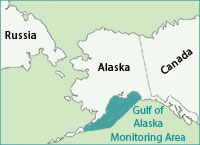 |
|||||||||||||||||||||
WELCOME, TEACHERS! The Alaska SeaLife Center and Gulf Watch Alaska are excited to present this virtual field trip (VFT). Join the Gulf Watch Alaska team of scientists as they investigate the long term effects of the Exxon Valdez oil spill on the ecosystems of the Gulf of Alaska. Learn about the work of a collaborative team of scientists from many different ocean science disciplines, who represent over 15 different government agencies, non-profit research institutions, and universities. GRADE LEVEL: 6-8th TIME NEEDED: Between one and four 1-hour class periods (teachers may choose to use all or only some of the supplementary lessons). NUTSHELL: Students will learn about the long-term monitoring projects that have been studying the effects of the 1989 Exxon Valdez oil spill in Prince William Sound and the northern Gulf of Alaska. They will explore the various projects and how, collectively, they can inform us about the overall ecosystem. LEARNING OBJECTIVES:After completing this virtual field trip, students will be able to:
BACKGROUND: In this virtual field trip, students will meet various scientists and researchers working for the Gulf Watch Alaska long-term ecosystem monitoring program, a project of the Exxon Valdez Oil Spill Trustee Council, encompassing the marine ecosystems affected by the 1989 oil spill. This program is organized into four related ecosystem monitoring components, with data management, modeling, and synthesis components providing overall integration across the program. This VFT can be used in a number of ways. Individuals may navigate through the pages on their own and meet the scientists through the links provided on the right-hand bar. Self-guided exploration can be completed in a couple of hours. Alternatively, teachers may facilitate a structured experience, working through each page of the VFT together in a class. Lesson plans (links included on the right-hand column of this page) are available to supplement online content. TO USE THIS VIRTUAL FIELD TRIP YOU WILL NEED:
UNABLE TO RUN THE STREAMING VERSION? REQUEST A FREE COPY OF ALL MATERIALS ON CD BY EMAILING education@alaskasealife.org. ADDITIONAL RESOURCES: • Alaska Ocean Observing System • Nearshore Ecosystem Projects • Ecological Trends in Kachemak Bay • Nearshore Benthic Systems in the Gulf of Alaska • National Park Service SWAN Nearshore Monitoring • Environmental Drivers Projects • Continuous Plankton Recorder • Gulf of Alaska Mooring (GAK1) Monitoring • Oceanographic Conditions in Lower Cook Inlet and Kachemak Bay • Oceanographic Conditions in Prince William Sound • The Seward Line: Marine Ecosystem Monitoring in the Northern Gulf of Alaska • Harlequin ducks and sea otters • EVOS Status of Injured Resources and Services • Detection of Seabird Populations • Fall and Winter Seabird Abundance • Prince William Sound Marine Bird Population Trends
Contact Us: If you have any questions about this virtual field trip, please contact the Alaska SeaLife Center Education Department at education@alaskasealife.org or 907-224-6306. For more information on classes we offer, including our inquiry-based 50-minute Distance Learning programs, visit our website at www.alaskasealife.org.
|
CURRICULUM SUPPLEMENTS Use the .pdf links below to access classroom activities for each section of the Gulf Watch Alaska virtual field trip experience.
|
||||||||||||||||||||
 |
|||||||||||||||||||||

